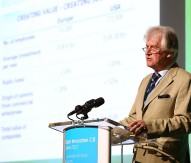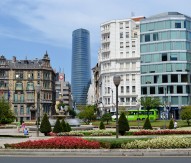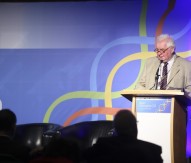

© Intel Corporation
Challenging the status quo
Open innovation will help the European Commission achieve its vision of Europe 2020, as well as help build a sustainable economy and society. That is the central goal of Professor Dr Martin Curley, director of Intel Labs Europe and chairman of the Open Innovation Strategy Policy Group (OISPG). By bringing together business, government, higher education and citizens in a quadruple helix innovation configuration, it’s hoped this concept can be realised.
Speaking to Pan European Networks on the sidelines of the ‘Open Innovation 2.0’ conference, Curley began by outlining the background to the ‘Open Innovation 2.0 paradigm’.
The OISPG is a collection of leading industrialists and academics that have been assessing open innovation for the last number of years and today we have this collision of three megatrends: digitalisation, mass collaboration and sustainability. Digitalisation is Intel’s business, and, with our partners, we are advancing information technology. The cost of information keeps falling and that presents a great opportunity for us to substitute IT for those resources. In the music and book industries, IT and digitisation have enabled a transformation that has been great for society and we now have better access to these mediums. This is at a lower cost, is more sustainable and more energy efficient. We think the same pattern can be applied to different industries.
About 30 years ago, Peter Russell wrote a book called ‘The Human Brain’. He talked about the emerging state of human consciousness when we are all interconnected. For the first time ever in the next decade, we are all going to be interconnected and that is going to be a very powerful resource. People are realising that we have to do more with less and the path that we are on is currently unsustainable. Therefore, the mix of those three mega-trends, as it’s fermenting, is actually creating this fantastic opportunity for disruption and Open Innovation 2.0 is about harnessing that; integrated collaboration with everybody in society participating.
We talk about quadruple helix innovation (government, industry, academia and citizens working together), and we can drive structural changes far beyond the scope of what any one organisation can do. The Mansion House exhibition in Dublin shows real examples of quadruple helix innovation, where citizens and business owners are working with Dublin City Council and companies like Intel and Glen Dimplex to shape the future of the city.
We also talk about shared value, a new form of capitalism where you want to be profitable, but also want to add value to society too. Intel’s vision statement is ‘creating and extending computing technology to connect and enrich the lives of every person on Earth’ and that’s a vision that I personally can really sign up to – we can be profitable, but we can also make a difference. We are trying to create a shared vision of what Dublin and London should look like in the future. By developing a shared vision with a shared value, we can develop exponential technologies that give extraordinary benefits. We are really focusing on adoption because most of the benefits from innovation come from adopting inventions, although we have far more ideas than we can actually use!
You spoke recently how the telecoms sector needed a ‘Ryanair’ to invigorate and re-energise the sector. How do you envisage such action occurring and removing that innovation bottleneck?
The airline industry in Europe used to be heavily regulated and everybody knew the norm. Entrepreneur Michael O’Leary saw a different way of working. O’Leary essentially copied the model of Southwest Airlines in the US. It was a classic business model innovation; completely disruptive. They transformed their fleet of aircraft and rethought what was necessary on their planes, from seatback pockets to magazines to litter bins. They got some great deals on buying their planes from Boeing and reduced their cost base.
Ryanair introduced a succession of innovations and I think this is what needed in the telecoms sector, where the only surprise for the consumer is the operator. Skype has been hugely successful, but why have they not been even more successful? If you look at the offering as a consumer, I can pay my telecoms provider or I can use Skype – presently it’s the convenience and the quality that is the issue. If Skype can increase quality, and this is the classic story of disruptive innovation, and become a major player with a lower cost base, eventually this will help displace the incumbent operators.
We probably need ‘Skype on steroids’ and the EU is doing its job to remove regulation. However, we still have exorbitant roaming charges in the EU and this is a hugely unfavourable to businesses. Arguably, Ryanair has acted as a huge, unpaid, integration service. They have helped more Europeans travel more cheaply, become connected and helped ideas across borders – we need the same in the telecoms sector.
I appreciate that the telecoms sector is experiencing a lot of pain because the data in their networks and traffic coverall is growing, though also along with revenues, yet we need to think about fairness. Arguably, some of the most profitable over the top operators are not bearing the cost; we likely need a more equal distribution of costs and profits in the entire industry and that’s partly the solution. If a company is earning disproportionate profits, other firms will consider this unsustainable; they will need to innovate. For the industry to become sustainable you have to look at the holistic business model and where the profits are being made. This is part of the natural dynamics of the market. If innovation is completed with shared value in a ‘win more, win more’ scenario, you have a virtual circle of success.
What do you consider the other main challenges facing European R&D today?
I think we need to shift our focus. The easy part of innovation is the ideas, yet having them adopted is difficult. We need to invest more in the adoption of products rather than just simply inventing.
We also need to change the culture. Currently, if you’re an entrepreneur and you fail in Europe, you’re finished. Yet on the West Coast of the USA, it’s like a badge of honour. I think this really comes down to cultural differences and we need to change this.
There is also an issue around the availability of venture capital in Europe. It’s very easy for venture capitalism to flourish when everybody is investing their money, but the real difficulty is in the seed money and this is where governments need to step-up and take risk.
In Ireland, we have a programme for high performance start-ups run by Enterprise Ireland yet, compared to the US, we have considerably lower seed funding and venture capital. Europeans need to take more risks. Israel has had more NASDAQ start-ups than all of the EU27 combined in the last ten years and I think that’s a frightening statistic.
Professor Dr Martin Curley





